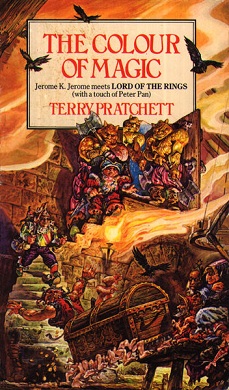
The Colour of Magic
Terry Pratchett
285 pages
published in 1983
The days are getting shorter, the nights are longer and I got the desire to reread some old favourites. It's the time of year for comfort reading, as you may notice in my reading patterns from year to year and this time I wanted to lose myself in something actually good, rather than going for something mindless. Which is why I decided to reread the Discworld series from the beginning, though I won't guarantee I'll finish the series.
Which brings me to The Colour of Magic, the very first Discworld novel. Over the years it has gotten somewhat of a bad reputation amongst Pratchett fans as not being up to the standards of the series, not being as funny or interesting, not a good place to start the series as a new reader. All of which has a kernel of truth, but at the same time it was the novel that kickstarted the whole series and if it really had no merit, it would've been the last book in the series. It is rough and ready, it doesn't quite fit in with the Discworld as it would evolve over the course of the series, but it still has a certain charm.
Most of this charm of course is due to the Discworld itself, one of the great fantasy creations, an idea so brilliant and yet so obvious you wonder why nobody else thought it up earlier to use as a setting for a fantasy series. The idea of the world being shaped like a disc, rather than a ball and carried by four elephants who themselves stand on the back of a giant turtle, with the moon and sun small satellites of the Disc, is of course inspired by various mythologies about the shape of the earth; Pratchett himself had used the idea of a discworld in a more dark humoured science fiction novel, Strata. But it was only in The Colour of Magic that he put it all together.
What he uses this wonderful setting for is parody,as he moves through several cliched fantasy adventures through the course of the novel, through the travels of the Discworld's first tourist and his reluctant tour guide. It's somewhat of a picaresque novel, a series of loosely connected adventures with no real overarching plot. It's also incomplete, as it ends on a cliffhanger.
It all starts with the arrival of that first tourist, Twoflower in Ankh-Morpork, where luckily for him, he meets up with failed wizard Rincewind, a man who has honed his survival instincts to a fine edge, to the point that he's already running away when most people would still ask why. As Twoflower takes a liking to him and once the Patrician of Ankh-Morpork explains he's a citizen of the Agatean Empire, the richest, most powerful and secretive empire on the Discworld, it is in his best interests to steer Twoflower away from danger, Rincewind becomes his guide. Which is sorely needed as Twoflower himselfs believes the best of everything, is convinced that his status as tourist will shield him from all dangers and in general is blind to any danger.
Which is how he ends up selling innsewerants to a landlord for about twenty times the value of his pub, setting into motion a conflageration that consumes the whole city, leaving him and Rincewind to flee for their lives. From there on their travels take them on a tour of the whole Disc. It's all in service of parody, as they meet up with heroes like Bravd the Hublander and the Weasel, Cohen the Barbarian and others vaguely reminiscent of other, more serious fantasy heroes..
What's striking about these adventures is how crude it all is. Take Death for example, who is downright cruel is his appearances here, taking great pleasure in spoking Rincewind and actually taking the lives of various animals directly, not at all the mellow Death we learn to know and love only a few novels later. It doesn't really feel like the real Discworld, with several elements contradicted by later novels (as shorta kinda worked out in Thief of Time).
All in all this is a decent enough read, but reading it in hindsight it's clear Pratchett is still learning how to make the Discworld work for him, isn't quite there yet. Reading it on its own will give you the wrong idea of what the Discworld series is really like.
Webpage created 17-10-2012, last updated 22-10-2012.